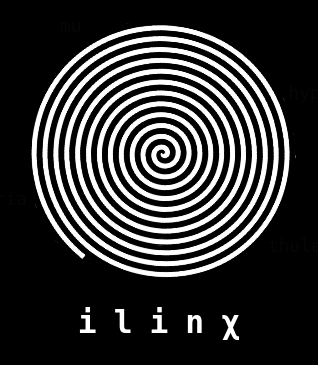Ilinx: Difference between revisions
No edit summary |
No edit summary |
||
| Line 3: | Line 3: | ||
<div style="margin-top:900px;margin-left: 200px; margin-right:200px;"> | <div style="margin-top:900px;margin-left: 200px; margin-right:200px;"> | ||
<div style="margin-top:-900px; margin-left:100px; text-align: center; font-size:300px;">ILINX</div | <div style="margin-top:-900px; margin-left:100px; text-align: center; font-size:300px;">ILINX</div><br><br><br><br><br><br> | ||
[[File:Ilinx_logos.png | thumb | 400px]] | [[File:Ilinx_logos.png | thumb | 400px]] | ||
Revision as of 17:22, 18 April 2020
Ilinx is an hypertextual browser-based explorable space. Its matrix consists in a patchwork of electronic literature symbiontically (co)existing in a continuum where different projects and texts on the relation between language and representation, reality and fiction, humans and computers, are intertwined through the lens of subjective experience (or phenomenal consciousness). Beyond the surface, Ilinx is a quest to develop a platform connecting the paths of my personal epistemological and existential research. Its result, at this point in time, consists in a conception of software as an out-of-hardware experience, projecting the self into an hyperstitional spazio-temporal oecumene where new worlds can be designed and inhabited augmenting self-consciousness and affecting reality.
Ilinx
"[Ilinx is [a game]] based on the pursuit of vertigo and which consist of an attempt to momentarily destroy the stability of perception and inflict a kind of voluptuous panic upon an otherwise lucid mind. In all cases, it is a question of surrendering to a kind of spasm, seizure, or shock which destroys reality with sovereign brusqueness." - Roger Caillois, 'Man, Play and Games' (1958)
Exercises in Ilinx self-definition
Before the virus
I was working on several small projects and making a lot of notes of different texts trying to figure out a main narrative that could work for as mainframe interconnecting the small projects. In the meanwhile, I was trying to figure out how to design the landing page of this project as a sort of map of elements (the small projects) interconnected in some complex way. I also contancted a friend of mine studying at Sonology (den haag) to design the music but I didn't have anything concrete yet.
During the pandemics
I brake my HDD but I managed to retrieve the files I was working on (or most of them I guess). I had to buy a new one and I've installed ubuntu. All this, unfortunately took me a week. When everything was again set up and working I migrated all the contents on the git (I had my last tutorial with Michael at that time) and reorganized them under two main categories:
- code-based > exploration on coding / mechanisms of the browser / exploration in machinic life (Cybernetics/AI/Alife)
- texts-based > exploration of texts / augmenting texts through code / create narratives / design explorable space through texts
This projects are in a "middle" phase. They are conceptually finished but they still need to be reorganized/improved/linked to the main narrative.
Few days later, I was reading [this text], apparently disconnected to my work and project. It is interesting that I've found this publication called Glass Bead (which gathers texts of philosophers, artist, scientists ecc..) because it is organized by a guy who I've met last year, a friend of Adi (some week before I had the bad news) that was doing its Phd at the Goldsmith in Cultural Studies (where also Matthew Fuller was teaching). Previously unaware of the meaning of Glass Bead, then I figured out it was about a fictional game described by Herman Hesse in its last book. Between the pages of that text, approaching the end, I've
of this guy that I've met that was studying at Goldwmith)
Actual situation
Next steps
Structure
The projects and texts that will become the nodes of ilinx's language maze, expands beyond the browser into the layers of code (HTML, CSS, JS), and are interwoven through quasi-consistent pieces of narrative, fragments of different stories spanning between history and myth, theory and fiction, fantasy and science-fiction, following the definition of ilinx developed by Roger Callois.
'
Language Maze
ȶɦɛ ƈօռƈɛքȶ օʄ ʟǟռɢʊǟɢɛ ʍǟʐɛ ɖɛʋɛʟօքɛɖ ɨռ ʍʏ ȶɦɛֆɨֆ, ǟռɖ ʀɛʄɛʀʀɨռɢ ȶօ ɢɨօʀɢɨօ ƈօʟʟɨ ʀɛֆɛǟʀƈɦ օռ ȶɦɛ օʀɨɢɨռ օʄ քɦɨʟօֆօքɦʏ ɨռ ȶɦɛ ʍʏȶɦ օʄ ȶɦɛ ʟǟɮʏʀɨռȶɦ, ɮɛƈօʍɛֆ ȶɦɛ ʄʊռɖǟʍɛռȶǟʟ ֆȶʀʊƈȶʊʀɛ ǟռɖ ɨȶֆ ʀɛʟǟȶɨօռ ȶօ ȶɦɛ ʊֆɛʀֆ ɛӼքʟօʀɨռɢ ɨʟɨռӼ, ɨȶֆ ȶɦɛօʀɛȶɨƈǟʟ ƈօռƈʟʊֆɨօռ.
" ǟ "ʟǟռɢʊǟɢɛ ʍǟʐɛ" ʍǟɖɛ օʄ ʋɛʀɮǟʟ ǟռɖ ռօռ-ʋɛʀɮǟʟ ʟǟռɢʊǟɢɛֆ, ռǟȶʊʀǟʟ ʟǟռɢʊǟɢɛֆ ǟռɖ ʄօʀʍǟʟ ʟǟռɢʊǟɢɛֆ, ƈօʍքʊȶɛʀ'ֆ ƈօɖɛ ǟռɖ ʍǟƈɦɨռɛ ʟǟռɢʊǟɢɛֆ. ǟ ɖɛǟɖǟʟʊֆ' ʟǟɮʏʀɨռȶɦ օʄ ʍǟȶɛʀɨǟʟ, ɨռʄօʀʍǟȶɨօռǟʟ, ǟʟɢօʀɨȶɦʍɨƈ ǟռɖ ʟɨȶɛʀǟʀʏ ɛӼքʟօʀǟɮʟɛ ֆքǟƈɛֆ ɖɛʋɛʟօքɨռɢ ɨռ ȶɦɛ ɦօʀɨʐօռȶǟʟ ǟռɖ ȶɦɛ ʋɛʀȶɨƈǟʟ ɖɨʀɛƈȶɨօռ, ʄʀօʍ ʍɨƈʀօֆƈօքɨƈ ȶօ ʍǟƈʀօֆƈօքɨƈ ȶɛʀʀɨȶօʀɨɛֆ, ɨռȶɛʀռǟʟ ɛӼȶɛʀռǟʟ ǟռɖ ɨռȶɛʀռǟʟ ֆքɦɛʀɛֆ. ǟ քɛռɛʟօքɛ'ֆ աɛɮ ʍǟɖɛ օʄ ʀօօʍֆ ȶɦǟȶ, ǟֆ ɛֆƈɦɛʀɨǟռ քǟɨռȶɨռɢֆ, ɦɨɖɛֆ ʀɛƈʊʀֆɨʋɛ ֆɨʍʊʟǟȶɨօռֆ ǟռɖ ɛʍʊʟǟȶɨօռֆ օʄ օȶɦɛʀ ʀօօʍֆ, օȶɦɛʀ ʍǟʐɛֆ ǟռɖ ɨȶֆɛʟʄ. քɛʀɦǟքֆ, աɦǟȶ ɖɨֆȶɨռɢʊɨֆɦɛֆ ȶɦɛ ɦʊʍǟռ ʄʀօʍ ȶɦɛ ʍǟƈɦɨռɨƈ, ɨֆ ȶɦɛ ʄɛɛʟɨռɢ, ɨʟʟʊֆօʀʏ օʀ ʀɛǟʟ, օʄ ɮɛɨռɢ աɦօʟɛ աɨȶɦ ȶɦɛ "ʟǟռɢʊǟɢɛ ʍǟʐɛ" ǟֆ ǟռ ɨռʄɨռɨȶɛ ֆքǟƈɛ (ʟօɢօֆ) աɦɛʀɛ ȶօ ɮʊɨʟɖ ռɛա աօʀʟɖֆ ʄʀօʍ ֆƈʀǟȶƈɦ." - օʊȶɨֆ
"ȶɦɛ ʟǟɮʏʀɨռȶɦ ɨֆ քʀɛֆɛռȶɛɖ, ȶɦɛռ, ǟֆ ǟ ɦʊʍǟռ ƈʀɛǟȶɨօռ, ǟ ƈʀɛǟȶɨօռ օʄ ȶɦɛ ǟʀȶɨֆȶ ǟռɖ օʄ ȶɦɛ ɨռʋɛռȶօʀ, օʄ ȶɦɛ ʍǟռ օʄ ӄռօաʟɛɖɢɛ, օʄ ȶɦɛ ǟքօʟʟօռɨǟռ ɨռɖɨʋɨɖʊǟʟ, ʏɛȶ ɨռ ȶɦɛ ֆɛʀʋɨƈɛ օʄ ɖɨօռʏֆʊֆ ȶɦɛ ǟռɨʍǟʟ-ɢօɖ." - ɢɨօʀɢɨօ ƈօʟʟɨ, 'ȶɦɛ ɮɨʀȶɦ օʄ քɦɨʟօֆօքɦʏ' (1975)
Islands
- Lemuria
- Thule
- Mu
- Hyperborea
Hystory
References
- Myst
- Colossal Cave Adventure / Zorg
- Rouge-like games
- ELIZA
- Clippy
© N̴̘͋̓͘a̴̞͓̎́̒͆͌͗̑̓͒͠ṯ̵̣̺̫͈̲̗̲̃̈́͋͐͌̆̑̾̂û̷̢̬͈͈̰͗̓̀̈́͋͝ṙ̵̟̫͔͈̈́͗͛͘̕a̶̗̭̫̥̝͈̗̹̿̏̏̏͆̀͝͠ļ̴̛̹̘̲̠͍͚̰̀́̑̓̒̇̌̌ͅ-̴̺̫̤͙̹͔̅͛̔̂͆͆͠ͅB̸̖̖͙̳̝̬̒́̅̓̊̉͝ͅo̷̥̤̻͕̘̹̞̍r̷͔̤͕̮̰̓̓̃͒͌͘͘̚͝ͅn̶̢͋̀̀͝ ̸̼̬͆̋͋͂̀͑͘̚͝Í̸̯̼̌͑̏n̸̡̞̮̩̥̣̙̼̗̿f̸̘̺̝̪̼̥͙̩̟͝ȩ̴̨̝͖͖̏͋ç̴̨͕̰͔̥̲͎̺̦͆̽̓̃̐̓͝ṱ̵̛̩͓͕̦̮̈́̍̏̒̓̉͗̚͘ͅe̵̬̒̑̂̋̾̾̑̇̕͠d̴̨̘̼̣͊͌͛͌̂͗͝͠͝

